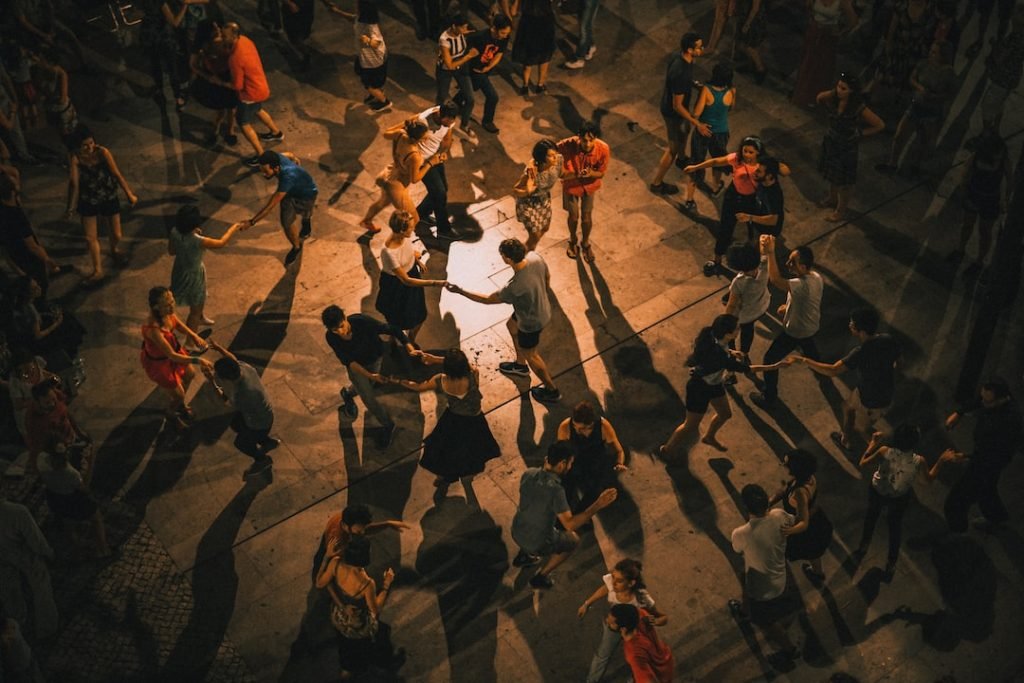

How to Discuss Dancing in Spanish: 30 Dance Terms
Spanish dance terminology is an essential part of learning and understanding the art of dance. Whether you are a beginner or an experienced dancer, knowing the correct terms and vocabulary is crucial for effective communication and expression. In this article, we will explore the basic dance steps and vocabulary in Spanish, popular Latin dance styles and their names in Spanish, the importance of rhythm and timing in Spanish dance, how to express emotions and feelings through Spanish dance, tips for improving your Spanish dance conversations, common phrases and expressions used in Spanish dance discussions, the cultural significance of Spanish dance and its impact on society, and resources for learning more about Spanish dance terminology.
Table of Contents
ToggleKey Takeaways
- Spanish dance terminology is unique and requires specific knowledge to understand.
- Basic dance steps and vocabulary in Spanish include terms like “paso” and “giro.”
- Popular Latin dance styles like salsa and tango have their own names in Spanish.
- Understanding rhythm and timing is crucial in Spanish dance.
- Spanish dance allows for the expression of emotions and feelings through movement.
Basic Dance Steps and Vocabulary in Spanish
To effectively communicate in Spanish dance discussions, it is important to have a good understanding of basic dance steps and vocabulary. Some common dance steps in Spanish include “paso” (step), “giro” (turn), “salto” (jump), “deslizamiento” (glide), “balanceo” (sway), and “rebote” (bounce). These steps can be combined to create various movements and sequences.
In addition to steps, there are also specific terms for body movements and positions. For example, “brazos” refers to arms, “piernas” refers to legs, “cabeza” refers to head, “cuello” refers to neck, and “espalda” refers to back. Positions such as “plié” (bend), “arabesque” (one leg extended behind), “pirouette” (spin on one foot), and “port de bras” (movement of the arms) are also important to know.
Popular Latin Dance Styles and Their Names in Spanish
Latin dance styles are known for their vibrant rhythms and energetic movements. Some popular Latin dance styles include salsa, bachata, merengue, cha-cha-cha, and tango. Each of these dance styles has its own unique characteristics and names in Spanish.
Salsa, which originated in the Caribbean, is a lively and energetic dance style that combines elements of Afro-Cuban and Latin American music. The word “salsa” itself means “sauce” in Spanish, reflecting the spicy and flavorful nature of the dance.
Bachata, on the other hand, is a sensual and romantic dance style that originated in the Dominican Republic. The word “bachata” refers to a type of guitar music that is often used in this dance style.
Merengue is a fast-paced dance style that originated in the Dominican Republic. The word “merengue” refers to a type of sugary confection, reflecting the sweet and energetic nature of the dance.
Cha-cha-cha is a lively and playful dance style that originated in Cuba. The name “cha-cha-cha” comes from the sound made by the dancers’ feet as they move quickly across the floor.
Tango, which originated in Argentina and Uruguay, is a passionate and dramatic dance style. The word “tango” itself has no specific meaning, but it is believed to have African origins.
Understanding Rhythm and Timing in Spanish Dance
Rhythm and timing are crucial elements of Spanish dance. They determine the flow and expression of the movements, as well as the connection between the dancers. Understanding rhythm and timing can greatly enhance your ability to communicate through dance.
In Spanish dance, rhythm refers to the pattern of beats or pulses in the music. It is important to listen carefully to the music and feel its rhythm in order to synchronize your movements with it. Different dance styles have their own specific rhythms, so it is important to familiarize yourself with them.
Timing, on the other hand, refers to the precise execution of movements in relation to the music. It involves knowing when to start and end each movement, as well as how to transition smoothly between them. Good timing requires practice and a keen sense of musicality.
To improve your rhythm and timing in Spanish dance, it is helpful to practice with a metronome or a rhythmic instrument. This will help you develop a strong sense of timing and improve your ability to stay in sync with the music. It is also important to listen to a wide variety of music and dance styles to expand your understanding of different rhythms.
Expressing Emotions and Feelings through Spanish Dance
Spanish dance is not just about executing steps and movements; it is also about expressing emotions and feelings. Through dance, you can convey joy, sadness, passion, love, and a wide range of other emotions.
One way to express emotions in Spanish dance is through the use of facial expressions. By using your face to convey different emotions, you can enhance the overall impact of your performance. For example, a smile can convey happiness and joy, while a frown can convey sadness or anger.
Body movements and gestures are also important for expressing emotions in Spanish dance. By using different parts of your body, such as your arms, legs, and torso, you can create dynamic and expressive movements that reflect the emotions you want to convey.
Music plays a crucial role in expressing emotions in Spanish dance. The rhythm, melody, and lyrics of the music can evoke different emotions in the dancers and the audience. By listening carefully to the music and allowing yourself to be moved by it, you can enhance your ability to express emotions through dance.
Tips for Improving Your Spanish Dance Conversations

Improving your communication skills in Spanish dance discussions is essential for effective collaboration and learning. Here are some tips to help you improve your Spanish dance conversations:
1. Practice active listening: When someone is speaking to you in Spanish about dance, make sure to listen attentively and focus on understanding their message. Avoid interrupting or thinking about your response while they are speaking.
2. Ask questions: If you don’t understand something or need clarification, don’t hesitate to ask questions. This shows that you are engaged and interested in the conversation, and it also helps you gain a better understanding of the topic.
3. Use body language: In addition to verbal communication, body language can also play a role in conveying your thoughts and feelings. Use gestures, facial expressions, and other non-verbal cues to enhance your communication.
4. Practice speaking: The more you practice speaking Spanish in dance discussions, the more comfortable and confident you will become. Look for opportunities to engage in conversations with native Spanish speakers or fellow dancers who are also learning the language.
5. Expand your vocabulary: Continuously work on expanding your Spanish dance vocabulary by learning new words and phrases related to dance. This will enable you to express yourself more accurately and effectively in conversations.
Common Phrases and Expressions Used in Spanish Dance Discussions
In Spanish dance discussions, there are several common phrases and expressions that are frequently used. Here are some examples:
1. “¿Cómo se llama este paso?” – What is this step called?
2. “¿Puedes mostrarme cómo se hace?” – Can you show me how it’s done?
3. “¿Podrías repetir eso, por favor?” – Could you repeat that, please?
4. “No entiendo” – I don’t understand.
5. “¿Cuál es el ritmo de esta canción?” – What is the rhythm of this song?
6. “Me encanta bailar” – I love to dance.
7. “¡Qué hermoso movimiento!” – What a beautiful movement!
8. “Estoy practicando para mejorar mi técnica” – I am practicing to improve my technique.
9. “¿Cuál es tu estilo de baile favorito?” – What is your favorite dance style?
10. “¡Vamos a bailar juntos!” – Let’s dance together!
Cultural Significance of Spanish Dance and Its Impact on Society
Spanish dance has a rich cultural significance and has had a profound impact on society. It is not just a form of entertainment; it is also a way to preserve and celebrate cultural heritage.
In Spain, dance is deeply rooted in the country’s history and traditions. Flamenco, for example, is a traditional Spanish dance style that originated in the Andalusian region. It is known for its passionate and expressive movements, as well as its intricate footwork and rhythmic hand clapping.
Spanish dance has also had a significant impact on society by promoting cultural diversity and fostering social cohesion. It brings people from different backgrounds together and provides a platform for cultural exchange and understanding. Through dance, people can learn about different cultures, traditions, and perspectives, which helps to break down barriers and promote inclusivity.
Furthermore, Spanish dance has also contributed to the economy by attracting tourists and generating revenue through performances, festivals, and dance schools. It has become an important part of the tourism industry in many countries, attracting visitors from all over the world who are eager to experience the vibrant rhythms and colorful movements of Spanish dance.
Resources for Learning More About Spanish Dance Terminology
If you are interested in learning more about Spanish dance terminology, there are several resources available to help you expand your knowledge. Here are some recommended resources:
1. Books: There are many books available that focus specifically on Spanish dance terminology. Some popular titles include “The Language of Dance: A Dictionary” by Mary Wigman, “Dance Terminology Workbook” by Karen Clippinger, and “Dance Anatomy” by Jacqui Greene Haas.
2. Online courses: There are several online courses and tutorials that offer in-depth lessons on Spanish dance terminology. Websites such as Udemy, Coursera, and DanceClass.com offer a wide range of courses for dancers of all levels.
3. Dance schools and studios: Many dance schools and studios offer classes and workshops that focus on Spanish dance terminology. These classes provide hands-on instruction and allow you to practice and apply what you have learned in a supportive environment.
4. Dance festivals and workshops: Attending dance festivals and workshops is a great way to immerse yourself in the world of Spanish dance and learn from experienced instructors. These events often include classes, performances, and opportunities for networking and collaboration.
Mastering the Art of Discussing Dancing in Spanish
Mastering the art of discussing dancing in Spanish requires dedication, practice, and a genuine passion for dance. By learning the basic dance steps and vocabulary in Spanish, familiarizing yourself with popular Latin dance styles and their names in Spanish, understanding rhythm and timing, expressing emotions through dance, improving your communication skills, and exploring the cultural significance of Spanish dance, you can enhance your ability to communicate effectively and express yourself through this beautiful art form.
Remember to continue learning and practicing Spanish dance terminology, as it is an ongoing process that requires constant effort. By immersing yourself in the world of Spanish dance, you can deepen your understanding of the art form, connect with others who share your passion, and experience the joy and fulfillment that comes from expressing yourself through movement. So keep dancing, keep learning, and keep exploring the rich world of Spanish dance!
If you want to learn Norwegian, you can register for classes here. We look forward to hearing from you and helping you become fluent in Norwegian.





